Abstract
Seasonal circular migration forms the backbone of India’s informal economy, but it has hardly been recognised as such by policymakers. Based on field experience in the Indian states of Bihar in 2024, specifically in the Katihar, Darbhanga, and Purnia districts, this article examines the causes of migration, including rural distress, caste-based exclusion, and gender disparities, and how these factors reinforce one another. Even though migrants form part of the urban labour market, they often exist without labour rights, secure housing, or advantageous social safety nets. Women shoulder even more responsibilities, as they typically perform informal and unpaid domestic work without institutional support. Thus, the paper highlights the following significant gaps in the policy domain: the low contribution of digital work platforms, such as e-Shram, and the lack of a coherent migration policy. Using both empirical evidence and a rights-based analytical framework, the paper presents an argument in support of inter-state coordination, gender-sensitive social protection programs, and legal amendments to establish portable rights. In this way, it argues that India must change its perception of the migration process as a matter of welfare and consider it a necessary labour process that would require security, dignity, and inclusion. Migrant workers are not a burden; they form the backbone of India’s economic future.
Keywords: Seasonal Migration, Informal Economy, Labour Rights, Social Protection, Rural-Urban Linkages
Section 1: Introduction
This paper examines labour migration (seasonal) to Bihar and its destinations in India in 2024, as well as the status of the country’s informal economy. Based on longitudinal fieldwork and secondary literature sources, it suggests that although such migration represents a critical source of labour for urban industries, the migrants are rarely offered advocacy and benefits. Every year, millions of villagers, primarily men and women from Bihar, Jharkhand, and eastern Uttar Pradesh, leave their villages after the harvest to demand jobs. Their work forms the foundation of the Indian urban economy, with projects such as building in Delhi and establishing cotton factories in Gujarat, among others. This is so, however, since the seasonal migrant workers are treated as a marginal group in the discussion of policies, they do not carry protection or any entitlement with them. The results of the 2024 field interviews in Katihar, Darbhanga, and Purnia, Bihar, show that migration is a survival strategy and an infrastructure of structural exclusion. It does not focus on availability, but rather on necessity; it is driven by rural distress, land fragmentation, indebtedness, and the inability of various schemes, such as MGNREGA, to generate sustained employment.
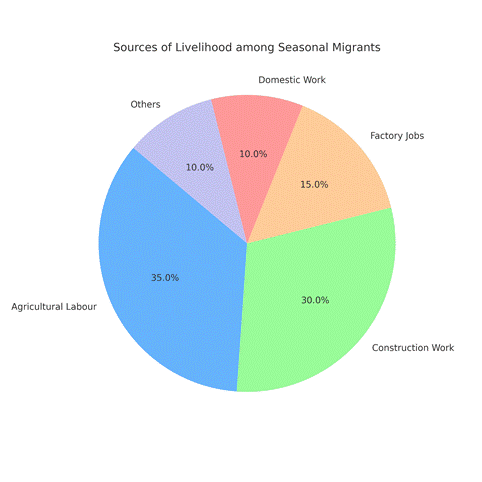
Source: NSSO (2011), Periodic Labour Force Survey (PLFS, 2017–2021)
This line graph shows the decade-long trend of increasing seasonal migration in India. It highlights how rural distress and urban demand have jointly driven migration cycles upward.
The 2024 Bihar fieldwork in Katihar, Darbhanga, and Purnia districts presented a more complex picture than the traditional interpretation of migration as purely economic. Instead, mobility detected acted as a survival strategy based on caste, gender, and geography. Despite this, the policies developed by the government still label migrants as temporary, as excess labour, and not as a permanent part of the labour force in India. This paper thus explores the seasonal migration of rural India. It puts forward the claim that the informal urban economy requires a flexible labour force open to exploitation and, to an extent, unprotected migrants, with the capacity to work in the city but be denied full rights to the town. From the 1970s to the present, over 80 per cent of the world’s population has been living below the poverty line (Srivastava, 2021; UNDP, 2021). Climate-related changes are increasingly determining the dynamics of such migration, with floods and unpredictable monsoons being among the factors that restrict agrarian livelihoods and increase the pressure on mobility. The research is based on qualitative ethnographic research conducted in the Indian state of Bihar in 2024, specifically in the Katihar, Darbhanga, and Purnia districts, involving 27 interviews with migrant workers, local contractors, and NGO agents. Policy documents and secondary literature have also been utilised to contextualise the findings. What this dynamics demonstrate, however, is a structural contradiction about how, despite the growing epidemiological dependence of the Indian economy on seasonal migration to fuel its informal economy, there is an absence of a corresponding structural discourse of the centrality of the worker.
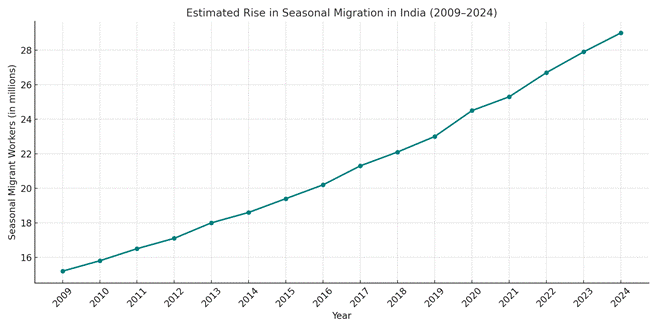
Figure: Trends in Seasonal Migration in India (2007–2022)
Source: NSSO (2007–08), PLFS (2017–18 to 2022–23), Ministry of Statistics and Programme Implementation.
Section 2: Mapping the Migrant Labour Landscape
The premise is that seasonal migration in India is an ancient phenomenon that, in recent times, has become more complex. Farmers in cities like Bihar, Odisha, and Chhattisgarh have started relying on it to fill the intra-annual income shortfalls or flee the distress of shrinking agricultural farm incomes. The movement follows its typical circular nature, with labourers going out during the low farm season and coming in during sowing and harvesting. The migration decision is shaped by wage differentials, chronic underemployment, caste-based discrimination in rural labour markets, and social networks facilitating job access in urban destinations.
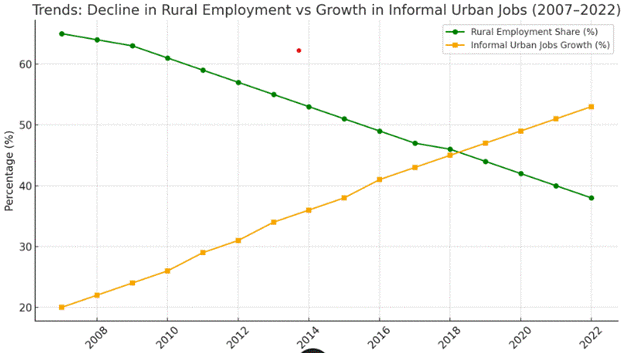
Figure: Declining Rural Employment Share in India (2007–2022)
This line chart shows India’s declining share of rural employment, illustrating structural shifts away from agriculture and rural occupations. This has directly contributed to rising seasonal and circular migration.
Source: NSSO (2007–08), PLFS (2017–18 to 2022–23), Ministry of Statistics and Programme Implementation.
Studies show that over 60% of circular migrants in India work in the informal sector (Srivastava, 2011; Keshri Bhagat, 2013), often without contracts, health coverage, housing, or labour protections. Migrants form a flexible workforce for urban industries, including construction, brick kilns, domestic work, transportation, and manufacturing. For employers, this offers a convenient model: a cheap, pliable labour pool that bears the risks of informal employment. For the state, it enables infrastructure growth without formalising rights. Recent ILO estimates (2023) show that over 90% of India’s labour force is informal, with migrants forming a significant subset—yet they lack a recognised labour identity or representation.
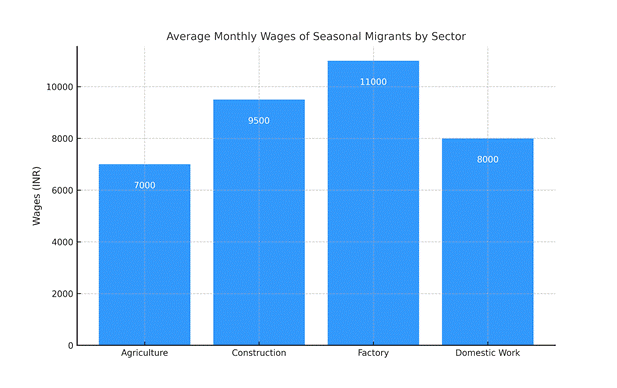
Source: Ministry of Labour and Employment, 2023; ILOSTAT, 2022
Figure 2 illustrates the occupational concentration of migrant workers in informal sectors, emphasising their critical role in urban infrastructure, yet their continued marginalisation.
Our 2024 fieldwork in Katihar, Purnia, and Darbhanga uncovered consistent patterns:
- Migration is a household-level strategy, not just individual mobility.
- Women increasingly accompany or follow male migrants, working in low-paid, gendered informal jobs (e.g., brick kilns, packaging, domestic labour).
- Local contractors and village intermediaries often control recruitment, leading to exploitative terms and high dependence.
- Lack of portable entitlements (ration cards, NREGA access, health insurance) deepens precarity.
Analytical evidence suggests that migration is not merely a labour-market adaptation tool, but a household-level response to structural limitations stemming from social stratification, inadequate state provision, and labour practices that favour exploitation.
Caste and community shape not only who migrates but also what work they find. Dalit and Mahadalit workers are overrepresented (Shah, Jodhka, and Lerche 2018) in harsh, low-paid sectors, such as brick kilns and sanitation, whereas OBC workers more commonly enter construction or logistics. However, these migrants remain invisible in official datasets. The 2011 Census counted over 139 million internal migrants, but the absence of recent comprehensive data (especially post-COVID) hampers planning. The lack of reliable post-2011 migration data significantly hampers effective planning. With the 2021 Census delayed, many estimates rely on scattered surveys, media reports, and NGO data rather than centralised state tracking. According to a 2022 report by the Ministry of Rural Development, there were significant gaps in the implementation process, as fewer than 40 per cent of informal workers could effectively register via digital platforms like e-Shram.
Our interviews revealed that, after years of returning to the same urban site, migrants had no stable housing and limited access to urban basic services. None of the surveyed workers in Purnia and Katihar had written contracts. Migrant workers live in makeshift settlements, often near industrial clusters, with poor sanitation and zero social infrastructure. As Jan Breman (2013) argued, this “footloose labour” is tolerated but not integrated, producing value for the city, but is excluded from its promise.
The migrant landscape is thus not only shaped by economic compulsion but also by structured exclusion. Recognising this dependency—and the need to guarantee rights and dignity—is essential if India is to transition from an economy of informalisation to one of inclusion.
Section 3: Gendered Realities of Seasonal Migration
Women form an increasing proportion of seasonal migrants, yet their contributions are chronically undervalued. In addition, Muslim women and Dalit women face dual marginalisation—not only by gender but also by religious and caste identity—further compounding their exclusion from urban informal labour protections. In brick kilns, construction, and domestic work, women often perform “invisible labour” that is neither formally recorded nor fairly compensated. Female migrants face greater vulnerabilities—lower wages, unsafe housing, gender-based violence, and the absence of maternity protections. A 29-year-old woman who lives in Katihar works long hours in a brick kiln. She has no sanitation facilities and must walk three kilometres back to her home after a day of work to cook food for her family, another unpaid care activity that is not counted.
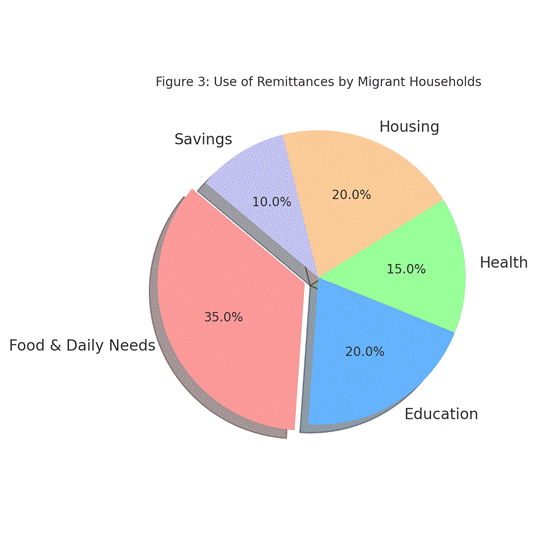
Source: India Human Development Survey (IHDS) 2022
This pie chart shows that a large share of remittances is spent on essential consumption (food, health, education), with limited room for savings or productive investment.
Such a spending pattern shows that remittances serve as a life-sustaining saviour to migrant families but do not lead to economic upward mobility or asset accumulation. After migration, migrant women still perform unpaid care work, which adds to their time constraints and enhances their non-representation in policy databases. Lack of real savings highlights the economic insecurity that migrant families had to carry on their shoulders. Our field notes from Darbhanga and Katihar reveal that women often migrate as unpaid co-workers accompanying male relatives, especially in brick kilns and farm contracts. Despite working equal hours, labour databases rarely recognise women as individual earners.
Protection systems are often based on patriarchal assumptions, thus shutting female migrants out. Since women migrants usually have no formal papers or their mobility is limited, the programs discriminate against them unwillingly. Therefore, it is necessary to have a gender-responsive migration policy that facilitates the incorporation of individual registration systems, safe shelters during transit, and full reimbursement for reproductive health services. These are essential steps in ensuring that social protection levels are equitable for migrants, regardless of gender.
Section 4: Towards Dignified Mobility and Inclusion
India needs a policy framework to support the transformation of the seasonal migration system, develop broader protectionist policies, and shift the focus to new promotion and inclusion policies. Seasonal migrant workers are not to be considered welfare people; on the contrary, they must work in the economy, especially in construction, brick kilns, agriculture, and food processing. Addressing these layered exclusions requires a multi-pronged policy approach. A forward-looking migration governance model must embed dignity, legal protections, and inclusive service delivery at its core.
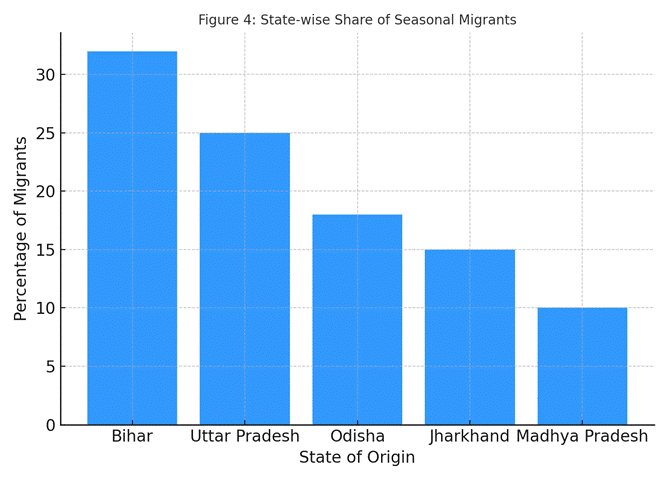
Source: Ministry of Rural Development, 2023; CMIE Migration Tracker
This bar graph ranks Indian states by their contribution to the seasonal migrant workforce, revealing Bihar, Uttar Pradesh, and Jharkhand as the top source states.
National Migration Policy
India urgently needs a full-fledged national migration policy. The current laws governing savings are scattered across various ministries and lack sufficient coordination. Establishing a coherent framework is intended to characterise seasonal migration, ensure the portability of entitlement across states, and impose dual responsibility on both the sending and receiving jurisdictions. The Draft policy on migration has been implemented. Therefore, there is a need to reconsider and reembrace these proposals.
Implementing a complete national registry, which embraces labour identity in terms of industry and geographical distribution, is imperative. Without universal registration, the differences between statutory rights and relative accessibility will persist.
Gender-sensitive Social Protection
Second, gender-sensitive social protection must be integrated into the policy architecture. With alarming regularity, women migrants languish beyond the boundaries of research, are disproportionately prevalent in unpaid or low-wage labour and face an elevated risk of violence and health threats. Therefore, a good policy should include clauses that guarantee maternity benefits, child care provisions, and safety on the premises. Programs such as the National Creche Scheme, Janani Suraksha Yojana, and the PM Matru Vandana Yojana should be expanded to cover the mobile population.
Portability of Rights
Third, portability of rights and services is the backbone of dignified mobility. This includes:
- Food security can be achieved by universalising and strengthening the ONORC system with better offline support and grievance redress.
- Healthcare access through Aadhaar-independent systems and interlinked state databases.
- Education continuity through transferable school records and hostels for migrant children, especially girls.
Worker-led Data Systems
The e-governance regime, with its employment-based platform, e-Shram, can provide a digital medium through which the informal labour market can be included. Empirical studies have shown that many workers still do not know whether they have been enrolled, and many data-entry errors are not addressed. Theoretical investigation emphasises that, in the absence of effective digital literacy programs and operating complaint redress, the overall positivity of e-governance can also increase in the place of reducing socio-digital exclusion. Therefore, the e-Shram portal has to be restructured so that people are actively registered; these efforts should be possible through the combined efforts of panchayats, NGOs, trade unions, and employers. The information generated by e-Shram should not be limited to confirming the registration, but should find application in policy formulation, monitoring grievances, and delivering benefits.
Decent Work Conditions
Fifth, decent work conditions must be ensured through:
- Implementing the Code on Social Security, 2020, with clear rules for migrant workers, especially in informal sectors.
- Local registration of employers and contractors, as per the Inter-State Migrant Workmen Act, with enforcement mechanisms.
- Employer accountability for housing, sanitation, and wage security. Housing subsidies under PMAY (Rental Housing) should be expanded to seasonal migrant clusters.
Inter-state Coordination and International Models
Sixth, inter-state coordination is critical. MoUs between sending and receiving states must include time-bound action plans, joint inspection teams, grievance redress platforms, and budgetary allocations. For example, Tamil Nadu-Odisha and Maharashtra-Jharkhand partnerships can be replicated in other state corridors.
Transnational engagement can inform the development of effective migration policies. The labour agreements established between Nepal and other destination states, as well as the dependency measures on overseas labour provided by the Philippines, demonstrate how regulatory systems can be utilised to incorporate migrants. In India, efforts such as the migrant hostels established in Kerala and the labour helpline systems in Odisha are good models that can be replicated. As a further mechanism to help develop the existing discourse, a paradigm based on giving needs to shift to one that focuses more on rights. The migrants are also an underclass, but they are full citizens and deserve services as well as dignity and representation in policy determination. Environmental scanning of migrants lived experiences is helpful in policymaking; inclusion of their lived experiences enables more progressive and inclusive regulations.
As India gears up its ambitions to become a $5-trillion economy, exploiting mobile labour or denying its fundamental rights can hardly be a viable strategy. In that regard, respectable migration is an ethical and economic duty. Instead of being a mere desirable occurrence, establishing a coordinated institutional framework is necessary, especially in the face of increasing displacement driven by climatic uncertainties, into the flood-prone areas of North Bihar. Achieving secure, informed, and equal mobility will ensure that India’s growth process is inclusive of its most mobile citizens.
Section 5: Conclusion – Rethinking Migration with Equity and Dignity
The current path of Indian development cannot be possible based on the unrecognised labour of invisible workers. There must also be a shift from the informalism of an extraction-based approach to a mobility approach that is ideally rights-based, as this is both economically and morally necessary for inclusive development. The key feature of seasonal migration in India is a high degree of contradiction: on the one hand, millions of people migrate to sustain the operation of the informal economy, but on the other hand, they are not included in official representations, influential policies, or discussions. Even though academic literature acknowledges intra-nation migration induced by poverty, rural discontent, or natural calamities, existing policy frameworks are not curbing the institutional inequity and policy blindness that seasonal labourers endure. All these weaknesses are also exacerbated by the absence of any political and social acknowledgement that regards migrants as equal citizens. The economics of policymaking that ignores the realities of migrants involves costs in the efficiency of economic processes, as well as democratic failure in terms of equality and justice.
Drawing on field insights from Bihar and secondary evidence, this paper highlights that internal displacement is not a crisis of movement but a failure of development. Migration of Katihar, Darbhanga, and Purnia districts is a forced movement caused by the collapse of local jobs and is not a voluntary geographic decision. This aspect of the development discourse charges the social costs to marginalised groups as it continues to expropriate labour to attain privatised profit and denies them all chances of security and social recognition. Once in the urban centres, migrants find themselves faced with low wages that never increase, a systematic shutout in terms of enjoying the perks of the state as far as welfare is concerned, and poor working and housing conditions. Sexual aspects of migratory processes make women migrants particularly susceptible, having to engage in free-of-charge domestic work and face increased sexual and occupational health threats.
Finally, the current results suggest that the migration system in India cannot be attributed solely to underdevelopment in rural areas; instead, it can be viewed as a deliberate mechanism of informalization. This means any policy intervention should focus on the migrant (women and Dalits, in particular), not as a temporary economic agent but as a citizen.
| S – Specific Legal Reform Amend and operationalise the Inter-State Migrant Workmen Act to include all types of informal recruitment (including self-organised and seasonal migration), with simplified registration and employer accountability. Ratify ILO Conventions 97 and 143 to align India’s laws with global standards on migrant labour. M – Measurable Social Protection: Expand the e-Shram database and link it with schemes such as Ayushman Bharat, PMAY, and maternity entitlements. Use real-time dashboards to track state registration, coverage, and service delivery gaps. A – Achievable Portability Reforms Ensure Offline Accessibility and Grievance Redress for ONORC and Health Schemes. . R – Relevant Gender Inclusion Measures Establish mobile creches, women’s shelters, and reproductive health services near labour-intensive sites. Train ASHA and ANM workers to cater to the needs of seasonal migrant women and children. T – Time-bound Inter-State Coordination Institutionalise bi-annual joint reviews between major sending (e.g., Bihar, Odisha) and receiving (e.g., Delhi, Gujarat) states. Allocate dedicated budgets under the Labour Ministry for inter-state MoUs with clear deliverables. |
In conclusion, India’s vision of inclusive growth cannot ignore the reality of its mobile workers. A development paradigm that ensures mobility with dignity, entitlements with portability, and work with security is desirable and essential. Ensuring inclusive citizenship through mobile social protection, gender-sensitive registration, and legal reform is not charity—it is a matter of justice. For India to grow equitably, it must stop treating mobility as vulnerability and start seeing migrants as builders of the nation, not its burdens. Only then can India’s development story be genuinely inclusive, anchored not just in GDP growth but in the lived dignity of its workers.
REFERENCES
Breman, J. (2013). At Work in India’s Informal Economy: A Perspective from the Bottom Up. Oxford University Press.
International Labour Organization (ILO). (2023). Informality and Employment Statistics in India. [Online Report].
Keshri, K., & Bhagat, R. B. (2013). Socioeconomic determinants of temporary labour migration in India: A regional analysis. Asian Population Studies, 9(2), 175–195.
NITI Aayog. (2017). Draft National Policy on Migration.
Shah, G., Jodhka, S. S., & Lerche, J. (2018). Caste and the Power of Discrimination: Dynamics of Exclusion and Inclusion in India. Routledge.
Srivastava, R. (2011). Internal migration in India: An overview of its features, trends and policy challenges. National Workshop on Internal Migration and Human Development in India.
Srivastava, R. (2021). Towards a Rights-Based Framework for Internal Migration in India. Institute for Human Development & UNDP.
United Nations Development Programme (UNDP). (2021). Human Development Report: India Supplement.


Leave a Reply